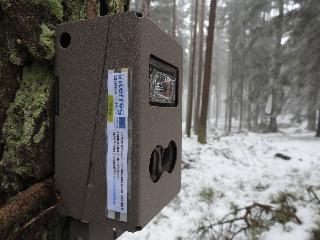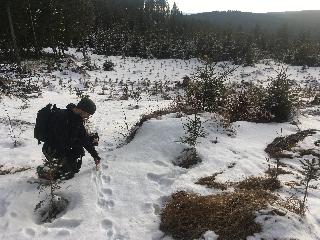Behind the Lynx of the Novohradské Mountains

We monitor lynx in the Novohradské Mountains and want to lift the lid on this elusive population.
Nowadays, camera trap monitoring is a basic feature of lynx monitoring in the Czech-Austrian-Bavarian borderland. We have already written a lot about how camera traps work and the possibility of identifying lynx by their individual markings. But where are the camera traps and what can we find out from them?
The camera traps are placed in a regular network by each 3Lynx partner who each has a defined area to cover. ALKA Wildlife is in charge of the Czech area known as the “free” landscape, i.e. outside the Šumava National Park and outside the Protected Landscape Areas. Specifically, we monitor:
- Some areas of the Bohemian Forest
- Border areas of Šumava
- The Brdy hills
- The area from Šumava to Novohradské Mountains
- The Javořice Highlands
Each quad must be monitoring in a way so that the presence, or lack of presence, of lynx can be confirmed. By tracking and sharing data together, movements of individual lynx can be followed.

_Image: Snow tracking lynx can help us estimate where to place our camera traps. _
In the winter, it is also possible to take advantage of ancient methods of animal monitoring: tracking. As well as using camera traps to locate lynx, in the winter we walk our defined areas to find tracks and traces of the lynx. It is possible to confuse the lynx with the track of a large canine or even a hare’s footprint. Therefore it is necessary to check for the following characteristics of a lynx track:
- Lynx have four, rounded toes which are visible in their track
- The pads are asymmetric in the longitudinal plane
- The middle pad is relatively large and has a trapezoidal shape
- The fur in between the toes make the track look “open”
- Lynx are able to retract their claws so you rarely see them in their track. On the rare occasion, such as on an uneven surface, they will create small round holes when imprinted.
- Lynx tracks are usually close together and run in a straight line.
- Measuring the pads the dimensions are approximately 6-9cm.

Image: Collecting lynx faeces to identify individuals.
When modern technology, DNA analysis, is added to this old method of tracking, it is possible to identify individuals, determine gender and the relationship between individuals. The aim of the analysis is be to find out if there are any negative effects of inbreeding in the lynx population of the Czech-Austrian-Bavarian border region. This method means that it is not necessary to physically catch the animals to obtain a sample. By “simply” finding and collecting samples, such as faeces, urine, hair or saliva, it is possible to extract the DNA. The collection procedure, however, is vital. When collecting samples, it is necessary do so using gloves so that the sample is not contaminated and the technician ends up analysing human DNA! Also, the wet samples need to be frozen as soon as possible to avoid sample degradation.
Lucky for us, in the Novohradské Mountains we did not only encounter lynx tracks, but also a forgotten picturesque corner of the world, in the middle of Central Europe. We think there is no need for more words, as that the photos say enough. If you don’t believe us, go have a look yourself. You can also read more about the 3Lynx project here.


